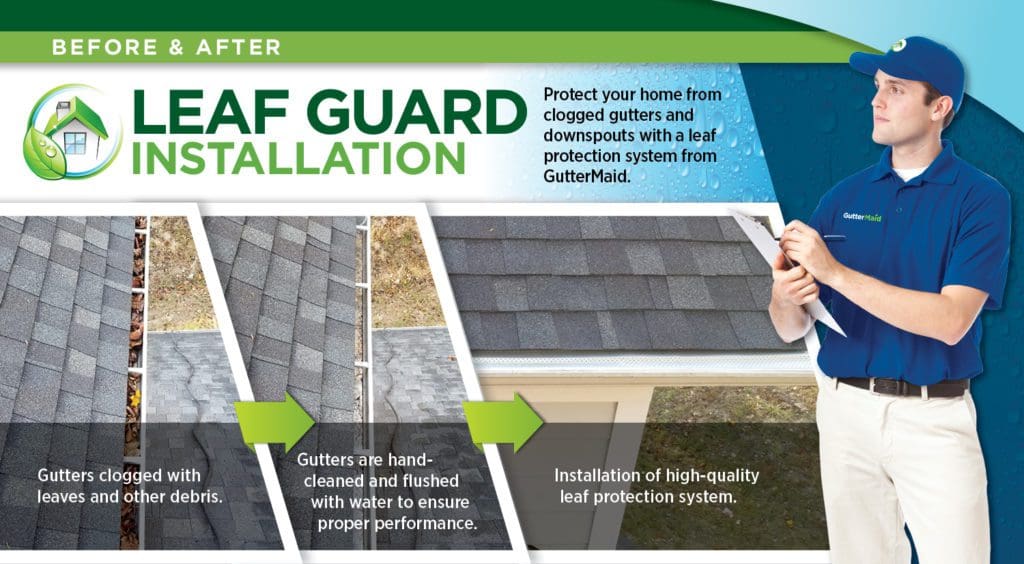Of coarse we always recommend hiring a professional to complete your gutter cleanings, but if you decide to tackle this dangerous and tiresome chore yourself, here are a few hints and tips to help you along.
1) Invest in the right tools: Having the right tools is a must to complete any task. You will need an extension ladder tall enough to reach the highest gutter on your home, unless your roof has a shallow enough pitch that you feel comfortable walking on it to access higher gutters. We also recommend using a ladder stand-off to stabilize the ladder, as well as to keep the ladder off of your gutters and prevent from damaging them. Bring a hammer so that you can re-nail any loose gutter spikes, a long hose, Gloves (very important!), a leaf blower to clear off roof debris, a drill with the proper 1/4″ hex head bit to disassemble downspouts if needed, and a clean-out tool for the downspouts. The top elbow section of each downspout is the most vulnerable point for collecting and trapping debris. Bringing a 2′ flexible pipe cleaner, or even a small section of hose can be used, to snake out the top of a clogged downspout and avoid having to disassemble the downspout to remove the clog.
2) Remove all accessible roof debris: Start with the highest part of the roof first and work your way down. A leaf blower really comes in handy here. The last thing you want to do is clean all of your gutters only to have the accumulated debris from your roof fill them up again.
3)Inspect your roof: While you are up on your roof clearing debris, it is a great time to inspect your roof , and its easier than you may think. A) Check for soft spots in the roof. while you are walking you may notice sunken in, distorted, or soft spots in your roof. These can be signs of possible water intrusion or attic ventilation issues. Check the area around and above the noticed area for punctures in the roof or missing shingles. B)Visually inspect the roof for missing/damaged shingles. Also note the age and general condition of the shingles. The average shingle has a 25 year life expectancy. As shingles age they will become thin as they lose what most people refer to as shingle grit, which you also may notice accumulating in your gutter. C) Check all penetrations in your roof such as fan, dryer, and plumbing vents. It is very common for the rubber gaskets around pipe vents to dry-rot and leak. You can get a few more years out of the pipe collar by sealing around the dry-rotted rubber gasket with a good roofing cement.
4)Clean & clear your gutters and downspouts: Start by removing the debris from your gutters by hand (don’t forget your gloves!). Just like your roof you want to start with the highest gutters first. You can bag the debris as you go on the roof but for safety reasons we recommend just throwing it down on the ground. It is much easier and safer to bag it on the ground. When throwing it down from the roof, try to throw it into piles to make clean-up easier. After you have removed the big stuff by hand we recommend flushing out the small debris and shingle grit left behind using a water hose. This will also help ensure that the downspouts are clear of debris as well. When using a water hose it is important to know where the hose is at all times. A water hose that is left dangling from the roof can cause havoc on your landscape, lawn ornaments, flags, etc., when moving around on the roof. We recommend pulling the entire hose up on the roof. Loop the hose around the top of the ladder rung or around a pipe vent to prevent the hose from sliding back down to the ground. Start with the highest gutters at the opposite end of the outlet/downspout. Work the debris to and down the downspout. Check the bottom of the downspout to ensure water is draining properly. If the gutter backs up with water then you most likely have a clogged downspout. Use your downspout tool to try to snake any clogs that may be at the top elbow section of the downspout. If that doesn’t work because the downspout is too severely clogged, or the clog is too far down the downspout, dissembling the downspout me be required.
5)Inspect your gutters: Make sure your gutters are draining properly. Gutters that are holding water are more susceptible to collecting debris, perfect breeding grounds for mosquitoes and other insects, can deteriorate the sealant in end caps, outlets , and miters, and can pull gutters from the fascia due to the added weight. If after flushing your gutters with water, the downspout is not clogged but the gutter is still holding water, your gutter may need to be replaced or re-pitched properly towards the outlet. This can happen due to bent or distorted gutters from improper maintenance or snow accumulation, natural settling of the house, or even a poor initial installation. Make sure your gutters are secured tightly to the fascia boards.Now days most gutters are installed using an internal bracket which is screwed to the fascia board and is not likely to pull loose. However, a lot of people will find that their gutters were installed using what is called a spike and ferrule. The spike looks like a large nail which can be seen from the outside of the gutter. The ferrule is the sleeve in which the spike is driven through and is found inside the gutter. With the weight of debris and snow accumulation these spikes tend to pull loose from the fascia board which can lead to fascia rot and even total collapse of the gutter. We recommend re-nailing any loose gutter spikes when cleaning your gutters. Using your hammer simply tap on each spike head until the gutter sets firmly to the fascia. You may notice that the spike does not hold and seems loose or keeps pulling away. If this happens call a professional to evaluate your gutters.
When finished with your gutter cleaning, be sure you do not leave any tools up on the roof. If you find any issues with your roof and/or gutters call a professional right away to avoid any costly water related damage that could result in the future. We recommend completing this important home maintenance at least twice a year, once in the spring and once again in the fall. However, every home will vary and you should adjust your gutter cleaning schedule accordingly.
Cleaning your own gutters can be hard work and very dangerous! If you decide to leave it to the professionals GutterMaid is here to help.

